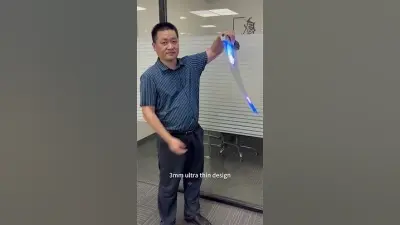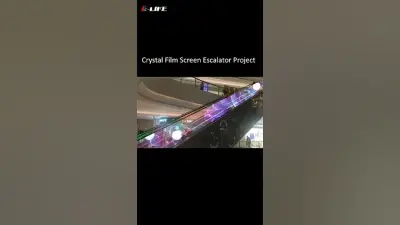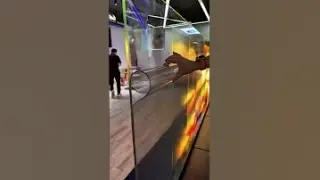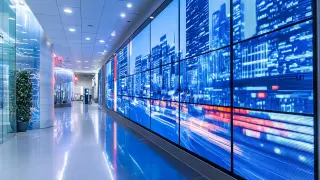
-
Home
-
Products
-
About Us
-
Case
-
News
-
FAQ
-
Contact Us
Leave Your Message

Currently, demands for new display solutions have risen in recent times owing to technology advancement together with the pressing need for advertising and information dissemination. The Transparent LED Flexible Screen has turned out to be a revolutionary change in the display world allowing more creativity and stimulating installations in many commercial and architectural applications undoubtedly. As per the MarketsandMarkets report, the global transparent display market is expected to have a market size of $2.18 billion by 2025 at a CAGR of 35.2%. Majorly, this growth is due to the higher-than-ever adoption of transparent displays in retail, automotive, and entertainment, thus providing extensive opportunities for enhancing customer engagement and brand visibility across industries.
Shenzhen Qianhai Hengyunlian Technology Co., Ltd. is therefore at the forefront of this innovative technology working in the development and applications of flexible transparent LED displays. Our commitment to providing cutting-edge multimedia transparent display solutions goes hand-in-hand with the industry trend in creating dynamic and interactive experiences. As the market continues to develop, it becomes important for the business to understand the multifaceted nature and applications of these Transparent LED Flexible Screens so as to maintain a head start in taking advantage of upcoming opportunities in an intensely competitive realm.

The growth trajectory of transparent LED flexible screens can be defined as astonishing, backed by advancements in technology and novel applications. Insights reveal that by 2033, the transparent electronics market is expected to surpass $789 million; the compound annual growth rate (CAGR) calculated from 2023 is 20.23%. The demand for such applications across sundry sectors including retail and automotive works towards increasing consumer engagement and immersive experience displays. In a nutshell, the growth is actually linear along with technology, with demand moving quickly into new applications with quick developments. Major tech fairs have attracted great attention to the launch of transparent MicroLED screens, demonstrating the diversity of applications for this technology. The applications of these displays go beyond the strong aesthetic presence of transparency to delivering lavish high-definition performance for digital signage and interactive installations. All this innovation from different manufacturers widens the horizons for new client use cases, thereby opening up possibilities that were once deemed impossible. As a focus for LED technology, transparency now finds increased funding and support for applications such as virtual productions, augmented reality, and immersive advertising. Companies want to test the waters with the capabilities of transparent screens to create compelling experiences to entice a new generation of consumers. The transparent LED flexible screen technology holds plenty of promise, especially with continued innovations aimed at redefining visual communication across diverse industries.
Flexible screens that create display media are changing how signage for the retail industry and advertisements are encountered. These screens, handily, offer some form of transparency over which dynamic artistic content leads to have the visibility they so desire. These screens are designed ideally in such a way that they become part and parcel of room ambience of the store, thus providing unhampered or beautiful viewing of products. With digital content layered atop their diaphanous surfaces, they are highly recommended for luxury markets and high-end retail affairs, where looks come next in line to customer engagement.
New-age fascinations, such as the reveal of a 60-inch transparent Micro LED screen, commonly testify toward such trends. Companies suck as AUO are particularly noted for their surprisingly high transparency and visual authenticity. By encompassing in themselves this discerning technology, images that grace the portals of retailers now whisper come-hither while suggesting some of the more animated forms of communication now believed to have risen from attention attempt in the way of the faces going into heiresses.
Their application extends well beyond mere display-type storefronts. Marketing, exhibition, and nightlife pop-ups certainly are domains into which these sculptural-media screens seem to fit. This vertical-retarget flexibility is bound to make LED transparent screens an important part of any retail and bona fide advertising blueprint within any retail perspective. However, as technology evolves, the potential for transparent-LED innovation is full of opportunity. This is in the bank for struggling businesses aimed at maximizing their potential reach.
The introduction of transparent LED flexible screens has ushered in a futuristic change in the display technology arena. This has led to a variety of advanced design possibilities. The functionality is wonderful, delivering excellent pictures while providing convenience in flexibility even in different spaces. Absen, BOE, and Visionox are going beyond the limits of display technology with things such as Micro LED, MIP, and OLED in the recently held DIC event where the giants in the display technology introduced and highlighted their most cutting-edge innovations to create more lifetime standards for the future of transparent displays.
According to a report by MarketsandMarkets, the market of transparent displays is estimated to have a valuation of USD 2.60 billion by 2024. The industry is growing at a compound annual growth rate (CAGR) of 27.4% from 2019. This is due to the ever-increasing demand for such innovations across retail, automotive, and architectural applications. The following would be the ability to create experiences without visibility as an important driving force for transparent LED. Industries are marking areas of interest where aesthetic value meets functional technology, creating distances at which awe-inspiring installations manifest in public realms and retail settings.
Transparent LED flexible screens can serve different applications, such as interactive advertising and real-time information dissemination. As an example, transparent displays are now entering the world of automobiles where awareness by the drivers is combined with infotainment aspects. With fixed innovativeness among companies such as Deepin Technology and Tianma, transparent screens are limitless in maximization of enhancement of user experience and are an essential consideration in contemporary design thinking.
Their transparent LED flexible screens at display have exhibited great speed and versatility, together with a plethora of applications. The new different dimensions of micro LED technology indicate that these displays will be perfectly transparent in the future without compromising performance. However, transparent displays will require very extremely fine pixelation as compared to normal LED screens, and micro LEDs can very well meet this due to their significantly small size. So this advancement makes the display much more transparent and adds much more visual excellence, thereby enhancing the industry change.
Weichuang's recent standards nationalizations contrast that it is beneficial for the industry to improve the health and quality of LED displays, paving the way for even more advanced technologies, such as transparent displays. Performance metrics, in turn, govern all applications to output data of high quality consistently, considering the most critical applications for end-users. Reports say that transparent LED demand is set to skyrocket, with estimates pushing the market using huge figures in the future. Everything about this growth is increased purely by a thirst for beautiful installations in retail and advertising where visual impact is of the most importance.
At the Consumer Electronics Show (CES) 2024, it was shown that competition would be heating up among transparent displays; rather, they should be showcased in devices, from vehicles to those for smart homes. The evolution of the market will add another layer of defining how the new technology will interact with or engage the user. This development certainly augurs to be a game-changer in the world of innovation that is upon us in the display tech arena. This cooperation by the industry in developing robust standards will be important for such growth as well.
Game-changing indeed; nowhere has it played out more than in comparison to old display technologies. Basically, transparent LED screens have increased the pace toward such a time where consumers would have greater or different expectations from their manufacturers because of awesome technology features. The emergence of such devices as transparent Micro LED screens indicates the transition of design towards a more integrated innovation that will entice but be also subtle to the senses.
Unlike conventional display technologies, which require physical enclosures and a significant amount of site space, transparent LED screens offer an unparalleled flexibility. All of them are used for receiving communicated messages-in windows, walls, and furniture-to facilitate a seamless transition between digital content and real life. Displaying crucial information without hindrance to visual observation becomes an ideal solution for applications in public transit, retail, and even smart homes. The launch at major tech events adds to demonstration of the commitment of the industry toward improving visual experiences using transparent displays.
With that, companies that are leading the industry of technology also mounted competition that inspires innovation within the practical bounds of practical advancements in the transparency of displays and quality of screen. With these objectives by the companies, new innovations in the techniques to come that make possible new applications for what may be termed as transparent screens are paved. The traditional display enters into the scene, as it should, but the transparency of LED screens has already ushered a revolution in the way humans will integrate digital mediums with their lives in the near future.
Transparent LED flexible screens have disrupted the display technology landscape with applications unique to various settings. Nevertheless, regardless of their advantages, significant challenges remain in installation and maintenance, which users must then negotiate. One primary installation concern is the need for special hardware and mounting solutions. These screens may be lightweight, yet their handling requires care so as not to damage them in any way. Proper installation alignment and calibration are critical for the best possible visual performance, skills that require professionals with an understanding of the technology's vagaries.
Maintenance of transparent LED screens is another cause for caution. Their flexible nature, besides their location in bustling or outdoor spaces, makes them prone to wear and tear. Their regular cleaning is vital to keep them clear and bright; that said, some techniques of cleaning can put the screen in danger. Moreover, failures in pixels and connectivity problems can spike up and require timely intervention to avoid downtimes. Hence, a good maintenance plan works best to assure durability and performance.
So, while transparent LED flexible screens can provide incredible versatility and aesthetic benefits, the utmost attention should be paid to their installation and maintenance. Getting these done by professionals experienced in the trade will go a long way toward eliminating any potential issues and maximizing the full potential of this new technology.
The future for transparent LED flexible screens definitely has a lot in store for some major innovations and breakthroughs that would change the scene of many industries. With the boom forecasted in the global market for transparent displays - estimated at a CAGR of over 20% from 2023-2030 - there has been an influx of brilliant applications that today completely alter the anterior thought about digital interfaces. The interest has especially been marked in retail and advertising, where brands have really dived into the use of transparent screens to create immersive shopping experiences, fusing product displays with vivid digital content.
Technological advancements would also make the displays miniaturized and more efficient. Transparent LED screens will now have better refinement with pixel density and have better brightness leading to their design in spaces where visibility and aesthetics count the most. According to the latest report by the industry, 60% of the new digital signage installations is expected to include transparent displays. This dominant trend is bound to be seen over the next few years mainly because installation of transparent displays is said to make engagements more dynamic and exciting for the consumer.
The advancements are making its way even into the architecture sector, with designers fitting LED transparent screens into the structure of the building facades, as well as interior spaces, in efforts to keep it visually attractive without losing natural light. We look forward to advancements in flexibility, energy efficiency, and connectivity, which will permit these systems to be more than just showstoppers but an integral part of smart building infrastructure. Those interested may have a bright sunny future ahead thanks to transparent LED flexible screens, which have been the subject of intensive research and development, with all potential applications appearing to be limitless.
Transparent LED flexible screens used in recent years have stolen the show in its application in several innovative sectors. One of the most dazzling case studies was seen at the ISLE exhibition when Tetris hosting an entire building building became a giant play in the blockbuster game. That very intriguing installation would attract everyone's eyes but continue to hold potential for using the transparent LED technology widely in urban design and interactive advertising without limitation.
On one hand, such flexibility and transparency allow these screens to be installed in existing buildings with undisturbed lines of sight. This, in turn, makes it incredibly cost-efficient and creatively available for advertisement, through which brands can sell themselves as a complementary design feature onto the architecture of the building. That particular installation mesmerized many people's imaginations and exemplified the potential that transparent flexible LED screens hold in transforming mundane environments into interactivities, reaching audiences in very uncommon ways.
Success stories have also come from other industries, particularly retail and hospitality, where establishments invest in these screens -like animated display, which does not only entice customers but also offers information plus entertainment that charges the customer experience. The evolution of transparent LED will foster, as some surety, in the future, endless linkages in the creativity of interacting with the surrounding environment in the sparkle of every building converted into an avenue for artistic creativity and brand narrative.
Transparent LED flexible screens are used to showcase products while maintaining an open atmosphere, allowing brands to overlay digital content on surfaces, which enhances customer experience, particularly in luxury retail.
Recent advancements, such as 60-inch transparent Micro LED displays, are increasing visibility and design quality, enabling retailers to convey promotional messages without obstructing views of their products.
Transparent LED screens are also being used in pop-up shops, exhibitions, and events, helping brands create immersive customer experiences.
The market for transparent displays is expected to grow significantly, with forecasts predicting over 20% CAGR from 2023 to 2030, leading to innovative applications in various industries.
Advances in pixel density and brightness are making transparent LED screens more efficient and ideal for environments where visibility and aesthetics are important.
Yes, transparent LED screens are being integrated into architectural facades and interior spaces, enhancing visual appeal while allowing natural light to enter.
An impressive case study featured a building transformed into a giant Tetris game during the ISLE exhibition, showcasing the potential of transparent screens in urban design and interactive advertising.
These screens attract customers by providing dynamic visual displays that offer information and entertainment, enriching the overall shopping or dining experience.
Future innovations are expected to include improved flexibility, energy efficiency, and connectivity, transforming these screens into integral components of smart building infrastructure.
By maintaining the aesthetics of building facades while enhancing visibility, transparent LED screens offer creative advertising solutions that engage audiences without obstructing views.




